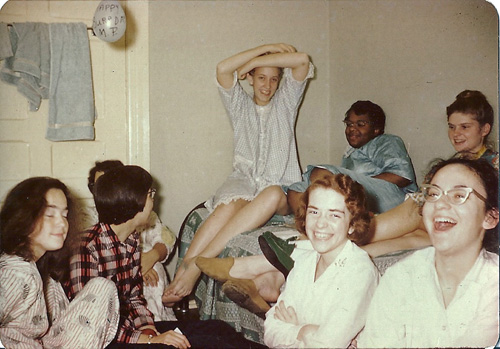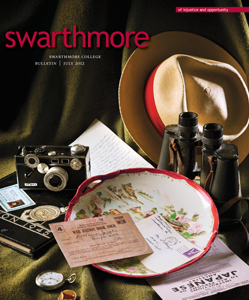The Great History Hoax of 1959
A Gaggle of First Years from the Class of ’63 Invent a Religion to Trick a Young Professor

Some of the Sherkites at a surprise birthday party for Nicky Pannwitt (arms up hiding the curlers in her hair) on Nov. 14, 1959, in her room on the Parrish 4W hall. From left: Anya Bozeman, Nina DiAngelo, Barbara Daly (hidden behind Nina), Nicky Pannwitt, Barbara Ravenell, Marilyn Tindall, Marcella Arnow, and Susan Womer (behind Marcella).
We freshmen in the Class of 1963 arrived at Swarthmore on a wave of euphoria born of freedom from parental control, the beauty of the campus, and the excitement of meeting talented peers from across the country. Quite soon, reality hit. All freshmen in those days had to take five full-credit courses. Each course, it seemed, required a staggering amount of work, especially the introductory courses in history and biology. Leo Braudy ’63 memorably complained, “Every time I learn a date, I forget a fish!” Midterms taught us humility, as valedictorians and National Merit Scholars saw Bs and Cs on papers and exams for the first time.
History I students were scattered among small discussion groups. Harrison Wright, the youngest history professor, had multiple sections of Western Civilization, which began with ancient Egypt, Mesopotamia, India, and China. He quickly discerned our near-total ignorance of Asia, sent us to atlases and other sources, and had us drawing mental maps of the rivers of India. We liked him, especially his dry sense of humor, and we enjoyed learning about Asia, but the course rapidly moved into the traditional focus on Greece and Rome. By November, History I had covered thousands of years and reached the Protestant Reformation.
Several freshmen women who lived on fourth-floor Parrish habitually studied in what was then the Math Library, a small room up a spiral staircase in the cupola. One dark November evening in 1959, we hatched a hoax.
Recently, some of us and Professor Wright shared memories by email and reconstructed that long-ago conspiracy.
Our thick Western Civilizations textbook had only a chapter on the Reformation, but every paragraph described one or more sects and their founders, theology, countries, and dates. Did Professor Wright, a specialist on New Zealand’s Maori, know all the reformation details that we were expected to memorize? Suppose we knew about a sect that wasn’t in the book. Would he admit there was something he didn’t know? Would any of his colleagues? Inspired to mount a tiny rebellion against the workload, we created our own sect.
We perused the list of contributors to one of the library’s journals of mathematics and found Frederick Sherk. The name resonated since we were shirking our duty to study, and it sounded convincingly central European. We decided our Frederick Sherk had lived and preached in Bohemia early in the 16th century. Then we introduced our sect in all of Professor Wright’s discussion sections. For example, one of us might say, “Lutherans, Calvinists, Sherkites, and Presbyterians all emphasized the individual’s personal relationship to God.”
To our surprise and delight, none of our name-dropping provoked challenge or comment from our professor. Was he pretending to know about the Sherkites, or hadn’t he noticed our insertions?
After the Thanksgiving break, we recruited volunteers from other dorms in sections taught by Professor Wright and by other professors. We coached our converts to insert Sherkites into their class discussions.
Same result: Still no reaction from the professors.
We developed a Sherkite theology so we could answer questions if challenged. Our Sherkites used the circle, rather than the cross, as a symbol of God’s universal love and connectedness. They greeted one other with a circular wave, saying, “May the Spirit be around you!” Frederick Sherk ordained his clergy by bathing their feet using rotating motions. And of course the Sherkite clergy rode circuits, preaching to their widespread followers. We began another “round” of inserting references to Sherkites into class discussions.
Our plot thickened: We introduced a Sherkite scholar—E.R. Englehardt, actually a classmate’s uncle in California. We found another student’s relative, who lived nearby and had a flair for dramatics, to be Englehardt. We enlisted him to give a lecture on campus after the winter break.
We sent an announcement to The Phoenix and posted flyers on bulletin boards advertising the lecture on Jan. 5 by a distinguished historian from McGill University in Canada (not easily verified, in those days before the Internet). Dr. Englehardt was the author of a forthcoming book, The Sherkites and Other Little Known Sects of the Reformation. We began to draft his speech—and plan his speedy exit at the end. When the next issue of The Phoenix appeared, we searched eagerly for our announcement. It wasn’t there.
Instead, we were shocked and horrified to read a long, angry letter to the editor from E.R. Englehardt. He insisted that he had no intention of coming to Swarthmore to give a lecture on Jan. 5 and was going to Afghanistan for several months! The letter went on to expose our movement as an “old and famous 18th-century hoax—long since exposed—that the Sherkites were … followers of a supposed 16th-century theologian named Friederich [sic] Sherk. There was … such an individual, as readers of my Einleitung zu der Geschichte den Vorreformations Theologie und Sektengrundlage (4 vols., Weimar, 1938) well know. . . . “Sherk” is a corruption of the old German “schurke,” a crafty or subtle person, and the name is particularly appropriate because it enshrines the personal traits which the Sherkites hold in the highest regard.”
Clearly, someone was trying to outhoax us. We quickly found out who had leaked our secret, as the culprit lived on our hall and confessed. A junior had mentioned the Sherkites in the Renaissance and Reformation seminar taught by Peter Riesenberg. He pounced, and her knowledge of Sherkite theology was too thin to answer his questions. She caved and revealed all she knew.
We quickly moved into damage control, taking the audacious step of calling Professor Riesenberg. We gathered by the rotary-dial phone on the wall in Parrish 4W hall. Identifying ourselves as Sherkites, we asked if E.R. Englehardt had left for Afghanistan yet. Claiming to be in direct touch with the man, he said Englehardt would not be returning to the United States for a very, very long time. We heard the humor in his voice and were sure he had written the letter to The Phoenix. He heard giggles at our end, asked how many of us were there, and then recited all our names. He then complained that we had wasted the time of history department professors who had tried to research the Sherkites. He also revealed that a faculty member in another department had asked about the Sherkites at a national conference during the Thanksgiving break.
The jig being so completely up, we went into emergency session and rounded up as many Sherkites as we could find to go visit Professor Wright and his family at home that evening. Walking down to their apartment on Crum Ledge, we made up Sherkite lyrics to some Christmas carols. At his door, we greeted him with the circular wave and announced that we had come to ordain him into our clergy. It was a hilarious ceremony involving a round basin borrowed from the college infirmary. Our favorite professor obediently took off his shoes and submitted to symbolic foot bathing as we intoned, “May the Spirit be around you.”
We then presented a couple of gifts that we had made that afternoon. One was a large round piece of an old sheet edged with colorful inscriptions: “MERRY CHRISTMAS FROM THE SHERKITES” and “WHAT D’YA HEAR IN SHERKITE CIRCLES?” In the center it said, quoting Frederick Sherk, “MAY THE SPIRIT BE AROUND YOU” and, below, “YES, WE ARE WELL-ROUNDED,” and “WE ARE TOO A CHRISTIAN SECT.”
The other gift was a round piece of cardboard to Wright from the Sherkites (opposite page). The Sherkites also had a letter mailed from Afghanistan from the fictitious Englehardt to “Father” Wright.
Our recent email exchanges revived a relationship that has remained warm since that evening on Crum Ledge. We aging Sherkites remain grateful for Professor Wright’s teaching in that first rough semester. In departing from the main thrust of the History I course to introduce us to non-European areas—and later creating the first course in African history at Swarthmore—he inspired several of the charter members of the Sherkite “faith” with a lifelong interest in developing countries.
Barbara Daly Metcalf ’63 became a history professor, specializing in Islamic movements in Pakistan. She recently completed her term as president of the American Historical Association. Barbara Ravenell Joshi ’63, now the widow of an Indian scientist, became a specialist in change among India’s Dalits (“Untouchables”), and divided her career between academia and human rights organizations. Monica “Nicky” Pannwitt Bradsher ’63 went to India as a Fulbright fellow, married an American foreign correspondent there, and was the educational media editor for the National Geographic Society. Marilyn Tindall Glater ’63, recently retired as a dean and professor of law at Tufts University, is an expert in African common law.
 Email This Page
Email This Page